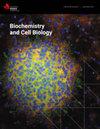Neurodevelopmental functions and activities of the KAT3 class of lysine acetyltransferases.
IF 2.1
3区 生物学
Q3 BIOCHEMISTRY & MOLECULAR BIOLOGY
引用次数: 0
Abstract
The human lysine acetyltransferases KAT3A (CREBBP) and KAT3B (EP300) are essential enzymes in gene regulation in the nucleus. Their ubiquitous expression in metazoan cell types controls cell proliferation and differentiation during development. This comprehensive review delves into the biological roles of KAT3A and KAT3B in neurodevelopment, shedding light on how alterations in their regulation or activity can potentially contribute to a spectrum of neurodegenerative diseases (e.g. Huntington's and Alzheimer's). We explore the pathophysiological implications of KAT3 function loss in these disorders, considering their conserved protein domains and biochemical functions in chromatin regulation. The discussion also underscores the crucial role of KAT3 proteins and their substrates in supporting the integration of key cell signaling pathways. Furthermore, the narrative highlights the interdependence of KAT3-mediated lysine acetylation with lysine methylation and arginine methylation. From a cellular perspective, KAT3-dependent signal integration at subnuclear domains is mediated by liquid-liquid phase separation in response to KAT3-mediated lysine acetylation. The disruption of these finely tuned regulatory processes underscores their pathological roles in neurodegeneration. This review also points to the exciting potential for future research in this field, inspiring further investigation and discovery in the area of neurodevelopment and neurodegenerative diseases.KAT3类赖氨酸乙酰转移酶的神经发育功能和活性。
人类赖氨酸乙酰转移酶 KAT3A(CREBBP)和 KAT3B(EP300)是细胞核中基因调控的重要酶。它们在后生动物细胞类型中的普遍表达控制着发育过程中的细胞增殖和分化。本综述深入探讨了 KAT3A 和 KAT3B 在神经发育过程中的生物学作用,揭示了它们的调控或活性改变如何可能导致一系列神经退行性疾病(如亨廷顿氏病和阿尔茨海默氏症)。考虑到 KAT3 在染色质调控中的保守蛋白结构域和生化功能,我们探讨了 KAT3 功能缺失对这些疾病的病理生理学影响。讨论还强调了 KAT3 蛋白及其底物在支持关键细胞信号通路整合中的关键作用。此外,文章还强调了 KAT3 介导的赖氨酸乙酰化与赖氨酸甲基化和精氨酸甲基化之间的相互依存关系。从细胞的角度来看,KAT3介导的赖氨酸乙酰化作用通过液-液相分离介导了亚核域的信号整合。这些微调调控过程的破坏凸显了它们在神经变性中的病理作用。这篇综述还指出了这一领域未来令人兴奋的研究潜力,激发了神经发育和神经退行性疾病领域的进一步研究和发现。
本文章由计算机程序翻译,如有差异,请以英文原文为准。
求助全文
约1分钟内获得全文
求助全文
来源期刊

Biochemistry and Cell Biology
生物-生化与分子生物学
CiteScore
6.30
自引率
0.00%
发文量
50
审稿时长
6-12 weeks
期刊介绍:
Published since 1929, Biochemistry and Cell Biology explores every aspect of general biochemistry and includes up-to-date coverage of experimental research into cellular and molecular biology in eukaryotes, as well as review articles on topics of current interest and notes contributed by recognized international experts. Special issues each year are dedicated to expanding new areas of research in biochemistry and cell biology.
 求助内容:
求助内容: 应助结果提醒方式:
应助结果提醒方式:


